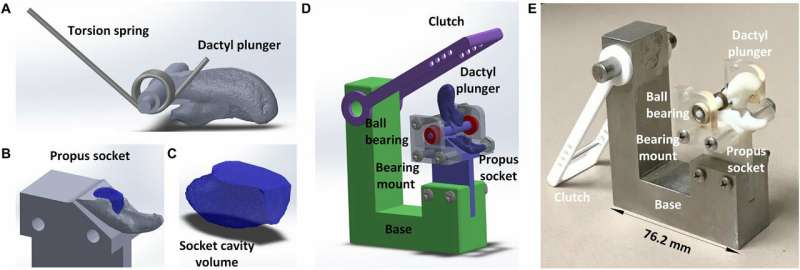March 18, 2019 report
Engineers copy snapping shrimp to produce underwater plasma

A team of mechanical engineers at Texas A&M University has found a way to generate plasma underwater by copying the snapping action of shrimp. In their paper published in the journal Science Advances, the group describes how they created a mechanical snapping shrimp claw in their lab and how well it worked.
Scientists have been able to create plasma underwater for some time—mostly by using electricity. Welding is done underwater using just such a technique. Lasers have also been used, but neither method is very efficient. In this new effort, the researchers sought to come up with a more efficient way to generate plasma underwater by mimicking the actions of the snapping shrimp.
Prior research has shown that snapping shrimp are able to produce both a shock wave and plasma using their outsized claw. The shrimp is able to generate both by closing its claw very quickly, forcing a plunger into a socket which expels a stream of water. The water moves so fast that a bubble is formed—which immediately collapses. The sudden low-pressure area forces temperatures up very quickly, making things so hot that light-emitting plasma is produced.
To recreate the mechanics of the shrimp claw, the researchers collected molted shells left behind by shrimp and by taking scans of real shrimp claws. That resulted in a design (five times larger than the original) which the team used to 3-D print their own snapping shrimp claw. Their model differed in some subtle ways, however, because they wanted the claw to snap without the use of muscle—they created tension using a spring-loaded rod, for example, which made the top part of the claw spin rapidly down onto their plunger.
In testing their claw, the researchers found that it was able to faithfully recreate the action of the real shrimp—setting it off resulted in the production of a shock wave and the production of light-emitting plasma. They also found that they could reduce the size of the claw without impacting its performance—in the shrimp, the claw needs to be big to house the muscle that slams the claw closed. They believe that additional tweaking could lead to the development of a device suitable for producing plasma in sufficient quantities for drilling or welding applications.

More information: Xin Tang et al. Bioinspired mechanical device generates plasma in water via cavitation, Science Advances (2019). DOI: 10.1126/sciadv.aau7765
© 2019 Science X Network



















